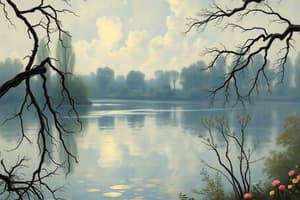Podcast
Questions and Answers
What are the five traditional senses that imagery can involve?
What are the five traditional senses that imagery can involve?
sight, sound, touch, smell, and taste
What is the primary purpose of imagery in literature?
What is the primary purpose of imagery in literature?
to engage readers by appealing to their senses
What type of imagery is used to describe physical sensations such as temperature and textures?
What type of imagery is used to describe physical sensations such as temperature and textures?
tactile imagery
What type of imagery appeals to internal sensations, feelings, and emotions?
What type of imagery appeals to internal sensations, feelings, and emotions?
Which author used visual imagery to describe the mountains in their novel?
Which author used visual imagery to describe the mountains in their novel?
Give three examples of literary devices that use imagery.
Give three examples of literary devices that use imagery.
Flashcards are hidden until you start studying
Study Notes
Sensory Imagery: Three Examples of Literary Devices
Imagery is a powerful literary device that allows writers to engage readers by appealing to their senses. Imagery can involve any of the five senses, including sight (visual), sound (auditory), touch (tactile), smell (olfactory), and taste (gustatory) imagery. In addition to these traditional senses, there are also two more types of imagery: kinesthetic and organic. Here are three examples of literary devices that use imagery to enhance the reading experience:
Visual Imagery
Visual imagery is the most common form of imagery in writing, as it is the best way for a writer to describe settings and scenes. It involves the use of colors, brightness, shape, and movement to create a vivid picture in the reader's mind. For example, in "The Hobbit," J.R.R. Tolkien uses visual imagery to describe the mountains, creating a sense of awe and anticipation for the reader.
Tactile Imagery
Tactile imagery describes physical sensations such as temperature, textures, pain, or other bodily sensations, enabling readers to experience the same tactile sensations as the characters. In "Jane Eyre," Charlotte Brontë uses tactile imagery to describe the character's discomfort, allowing the reader to feel Jane's coldness and dampness.
Organic Imagery
Organic imagery appeals to internal sensations, feelings, and emotions, such as fatigue, hunger, thirst, fear, love, loneliness, despair, and elation. It is subjective and contributes to it being a more difficult and complex form of mental imagery. For example, in Robert Frost's "Birches," the poet uses organic imagery to describe his longing to return to a simpler time, evoking feelings of nostalgia and introspection.
These three types of imagery, along with visual, auditory, gustatory, and olfactory imagery, are all powerful literary devices that writers use to create vivid descriptions that appeal to the readers' senses, making the narrative more immersive and engaging.
Studying That Suits You
Use AI to generate personalized quizzes and flashcards to suit your learning preferences.




